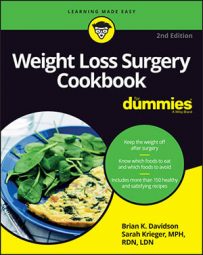What you can eat
You can enjoy some very soft normal foods again. In addition to the liquids you have enjoyed up until now, you can add things like- Blended lowfat cottage cheese (great source of protein!)
- Blended scrambled eggs
- Blended cooked vegetables
- Mashed or blended bananas
- Mashed potatoes made with skim milk
- Silken tofu
- Sugar-free applesauce
- Blended meats
- Lowfat ricotta cheese
You still can't consume large amounts of food. More than likely, you can only eat about 1/4 cup at once if you had gastric bypass, or 1/4 to 1/2 cup if you have a band.
Make sure your stomach is ready for this volume increase by increasing portions slowly. Listen to your body!Preparing puréed meals
You need to blend or food process most of your smooth foods to make them the right consistency. This is a bit of an art, and you may experience difficulty getting the right consistency at first. Should you need to thicken foods, you can add things like- 1 tablespoon mashed potato flakes
- 1 tablespoon nonfat powdered milk
- 1 tablespoon instant grits
- 1 tablespoon instant rice cereal
- 1 to 1-1/2 tablespoons unflavored gelatin or sugar-free gelatin
- Commercial thickeners (ask your pharmacist or support-group friends about the commercial thickeners they recommend)
- Nonfat milk
- Water
- Vegetable juice
- Broth
Invest in a food processor for smooth foods. You'll enjoy a much nicer result.
Smooth food tips
As you begin to introduce more foods, how you eat is just as important as what you eat. The following tips help you eat well and achieve your weight loss goals.- Skip the baby food. It often has added water, thickeners, and sugar. You deserve (and will enjoy) real food, so take a few minutes to try some new recipes.
- Use standardized measuring cups and spoons to measure what you eat.
- Introduce one new food at a time and only every couple of days.
- Continue to keep your food diary, including any unusual symptoms you may experience.
- Listen to your body and stop eating before you are full.
- You may need to eat four to six times a day to get all of the nutrients you need.
- Eat your protein foods first and use protein supplements between meals. You need to aim for 60 to 80 grams of protein a day, so you will probably need supplements to help you meet your needs, especially early on.
- Eat slowly and take small bites.
- Don't drink beverages with your meals, and wait 30 minutes after your meal to begin drinking again.
- Remember to get 48 to 64 ounces of fluid a day. Supplements can also help you meet your fluid requirements.
- Because you're able to eat only limited amounts, you need to eat nutrient-rich foods. In other words, you want to get the most nutritional bang for your calorie buck.
- Continue to stick with foods that are lowfat and sugar free.
- Use small plates and utensils to control portions.
- Take your multivitamins and any other supplements your surgeon or dietitian has recommended.
Sample menu for a smooth-food diet
You have many more options in this stage, which means it's easier to meet your nutritional needs (especially protein). Focus on using foods to meet your needs and only use supplements to fill in the gaps. The following sample menu shows what you may eat in a typical day:- Breakfast
- No-sugar-added yogurt
- Unsweetened applesauce
- Snack
- Low-carb protein supplement
- Lunch
- Cream of tomato soup made with nonfat milk
- Blended chicken moistened with chicken broth
- Blended green beans
- Sugar-free pudding
- Snack
- Low-carb protein supplement
- Dinner
- Blended meatballs with beef broth
- Mashed potatoes made with nonfat milk
- Fat-free gravy
- Blended carrots
- Sugar-free applesauce
- Snack
- Sugar-free pudding made with fortified nonfat milk or low-carb protein supplement (if needed to meet protein needs)

